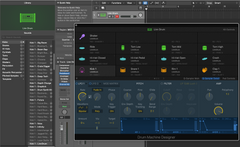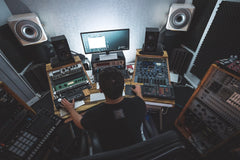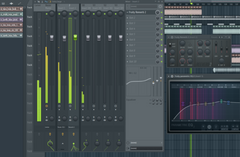AFTER THE LOUDNESS WAR: TECHNO MASTERING IN 2021
Founder of Riemann Mastering Florian Meindl told us a few important things about his approach to analog mastering for Techno & House music as well as how to master tracks for streaming platforms, digital online stores and vinyl.

How many LUFS should a song have to be loud on Spotify, Apple Music, Youtube and all streaming platforms?
In my experience you will get the best result if you go for a medium value of -12 LUFS on your meter for dynamic genres like House music and up to -7 LUFS for Techno music.
Here is why:
The year 2020 brought a significant turnaround in mastering - the music streaming platforms like Spotify, Apple Music or Youtube apply a so called "loudness penalty" for loud songs with little dynamics or a volume boost in case it's very dynamic music. The reason for this is, to guaranty an equal loudness within the platform.
What basically happens is, it adjusts the LUFS value of the song to the target LUFS value of the streaming service. By adjust, I mean simply a positive or negative volume change. The exact algorithm is not known to me but my suspicion is, that the loudest part of a song is analysed and adjusted in volume. If there comes a much louder peak somewhere else in the track it's simply cut off by a limiter.
Check out www.loudnesspenalty.com where you can analyse your track for free and see if it gets raised or lowered in volume by the various streaming services and compare the pre-master with the mastered track!
In the club a DJ does the loudness correction with the gain knob - but more and more mixers and digital players have this function built in already so that the DJ doesn't have to worry about different loudness levels anymore.
Florian Meindl showing his analog mastering chain 2021
Mastering for streaming platforms 2021
So, how should you master your track for a streaming platform? Well, the time of heavy limiting is in most cases over - except you want to get exactly this overcompressed sound.
So that leads us to the main essence of mastering after the loudness war, which is:
The track should be mastered in a way, so that it is well balanced in terms of frequencies and dynamics within the different frequency bands according to the genre.
A Disco track doesn't have to be made unnecessarily loud anymore and on the other hand harder genres within Techno can still have that hot sound of overdriven valves and peaking analogue gear with little dynamics because it's an artistic choice. The sound characteristics of the genre allow it to be less dynamic.
For more dynamic genres of music the mastering engineer can finally - again - concentrate on the piece of music as a whole and consider dynamics as an expression of art. The new mastering language in 2021 is about how warm or overtone rich a track should be, how smooth a compressor should shape the sound and glue the instruments together and not simply "is it loud enough".
Let's be honest it was mainly about how loud a track is compared to the competition and louder was better because the music online stores and back then CDs were all peak limited, which means, that when a song was dynamic it was too quiet and the louder songs were perceived as better.
Mastering tips for Techno in 2021
- Now that the loudness war is over, the most important thing is to get the energy level of a track right, which means the added overtones and the aesthetics of glueing together the elements of a track. I recommend to work without a limiter first so you can hear exactly what the compressors do - also make sure to have the makeup gain adjusted or the auto-makeup gain engaged.
- The possibility to have more room for transients gives us another resource in mastering, if an important element of the track needs that punchy dynamics then so be it - don't destroy it with a limiter and leave it dynamic.
- Avoid very dynamic sub-bass in Techno because in a club the subwoofers will most likely run on maximum all the time anyways and the PA systems have limiters on the subwoofers. The more you control it the less loudness penalty you will get on the music player from the DJ because the gain meter will show an unnecessary high level.
- Make sure you don't get a positive "loudness penalty" because then it will get turned up in volume and maybe a limiter from the streaming service will reduce the peaks of your song - you should do that yourself.
- So, what if a track sounds best with heavy limiting? The limiter can give the impression of an energetic sound but the problem is it processes the whole frequency spectrum so if the kick drum hits the peak it doesn't allow the hihat to have a higher peak at exactly that moment - so I would recommend a multiband compressor instead of a limiter to achieve an energetic overall sound. Use a high compression ratio in the bass area but reduce it in volume a bit. The higher you go with the frequencies the lower the ratio should be to keep the dynamics. This way you have a clear and dynamic high band but a very controlled energetic bass.
FREE Techno Mastering chain for Ableton Live
If you want to get started with your own mastering check out this free techno mastering chain which we have created in cooperation with Florian Meindl to get quick results! If you want to go for high end analog mastering please contact us at riemannmastering.com
Download the FREE Mastering chain for Ableton Live here
Vinyl mastering
I often get asked if I master differently for vinyl and the answer is "No, at least not for Techno". If I would do the vinyl cut also, then I would master it differently, because the cutting lathe where the vinyl is being cut, needs some adjustments especially in high frequencies and the bass must be mono under around 120hz but this is only because of the physical limitations of a vinyl cut - it should not bother mastering engineers who master tracks for digital release.
So if one of my mastered tracks gets released on digital platforms and vinyl, then my digital master file (which is 16bit WAV on 44.1Khz by the way) is adjusted by the vinyl cutting engineer for that specific cutting lathe. The adjustments will mainly be a 100% mono mix below 120hz so that the needle doesn't jump out of the groove and an adjustment of the high frequencies specific to the cutting lathe and the diamond which is used to cut the vinyl.
If you want to go for high end analog mastering please check out our dedicated website riemannmastering.com



